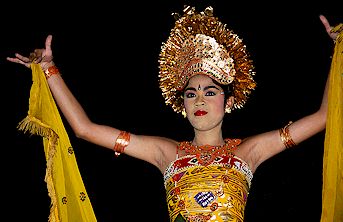|
|
|
|
Other Balinese Dances There is no shortage of dances in Bali. Sacred or secular, masked or unmasked, male, female, or mixed. The variety is endless. The easiest way to see a mix of dances is at one of the Legong
performances. Typically, there will be five or six dances performed, with only one of the
dances being the Legong. Let's look at some other dances. The Baris is a traditional war dance, performed by males. |
| The Oleg Tambulilingan or bumblebee dance, was
created in 1952, for a dance troupe that was going to tour the world. It's a dance that
depicts two bumblebees flirting in a garden. |
 |
|
Topeng is the Balinese word for mask, and this is a mask dance. There are many, many versions of the Topeng. As many as there are types of masks, in fact. In a true Topeng perfomance, the dancer will use many masks, assuming a different
character with each one. |
| The Calonarang is a story about a widow who practices black magic
in the town graveyard. This dance essentially combines all the other Balinese dances into one that is often actually performed in the town graveyard. In the story, the widow is putting many young women under spells and is asked to stop. The widow does not stop, and in fact turns into Rangda, the manifestation of evil. |
|
|
At this point, the Barong appears and we get the life and death struggle
of good and evil again. When the Calonarang is performed at festivals, it can go for hours and hours. There are bits of stand up comedy performed in sections of the play, solo dances are performed, there are variations of the legong, and a fair number of attendees fall into trances. I watched a festival performance in the wee hours of night for about four hours, but since I didn't understand the stand-up comedy bits (though it was interesting to see that the humor was very low-brow), I left in the middle of a long spoken passage. Still, it was interesting to see the differences between the tourist shows and the
'local' show (basically, more energy and audience interaction in the 'local' show). |
| I don't know the name of this dance, and in fact, I've seen
many dances that I can't identify. Typically, we watch dances about two out of every three nights that we're in Bali. If you go to Bali and you don't see the Legong, Barong, and Kecak dances, you haven't really been to Bali. |
|